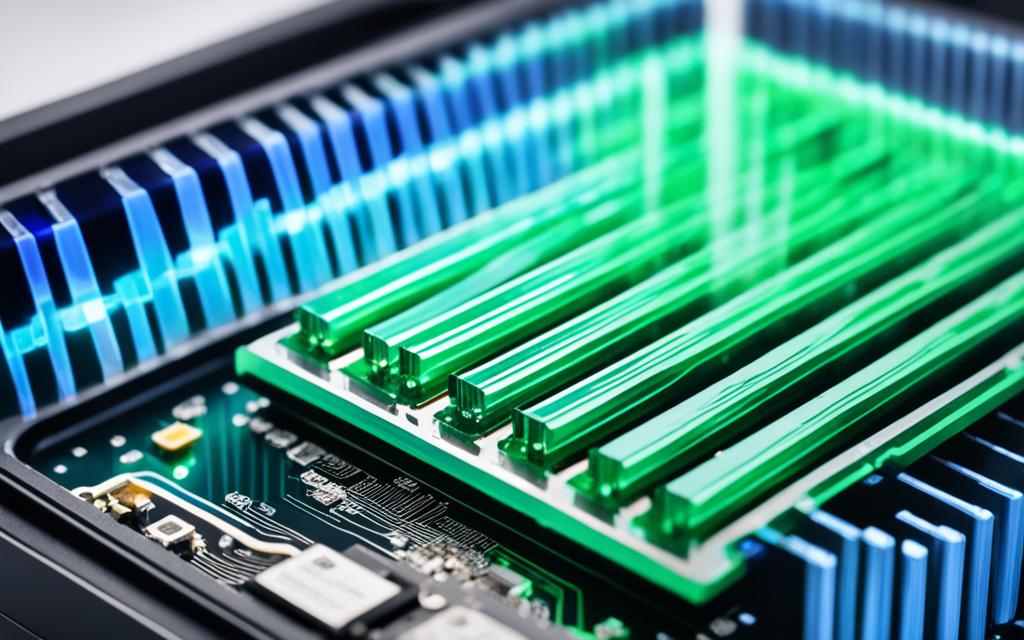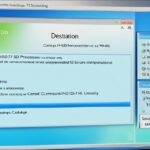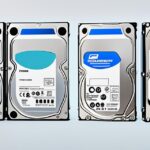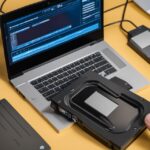Table of Contents
Making a copy of your hard disk drive (HDD) is key for anyone using a computer. It brings both security and peace of mind.HDD image creation lets you clone your drive. This includes the operating system, apps, and personal files. It’s vital for recovering data, restoring your system, and backing up. This matters a lot if hardware breaks or data gets ruined. Up to 82% of users say disk images help a lot with data recovery when there’s damage or the main disk needs reformatting1. Knowing how to make an HDD image keeps your important info safe and makes using your computer smoother. In this guide, we’ll cover the basics of disk imaging. We’ll also give step-by-step instructions to ensure you can protect your data confidently.
Key Takeaways
- HDD image creation can safeguard critical data and streamline recovery processes.
- Creating a disk image captures a complete picture of your storage device.
- Over 63% of users utilise Windows tools for effective disk imaging.
- System backups can take considerable time depending on data size and method chosen.
- Utilising professional imaging software can enhance backup efficiency and reliability.
- Opting for external storage or cloud services can protect you from data loss during imaging.
- Understanding the tools available is essential to maximise the benefits of disk imaging.
Understanding HDD Imaging
Understanding HDD image definition is essential for those involved in data management and recovery. An HDD image acts as a complete snapshot of a hard drive or partition. It captures all files and the structure of data. This process allows for accurate system replication or recovery at any point.
What is an HDD Image?
An HDD image is essentially a compressed copy of the whole hard drive, often stored as ISO files. It’s made through disk imaging, which copies every bit of data exactly. There are full and differential images. Full images capture everything, while differential images just save changes since the last full backup2. This method makes storage management effective and keeps important data safe.
Why Create an HDD Image?
The advantages of HDD imaging are vast, covering areas like data recovery, forensic examination, and easy data transfer. When systems fail, an HDD image can speed up the process of getting things running again. Disk backups are useful for cloning drives, especially when upgrading to SSDs or larger HDDs. Cloning lets users make exact copies of drives or partitions quickly, keeping data current.
Unlike cloning, imaging allows for data storage remotely, with data optimisation through compression3. This flexibility and efficiency can significantly cut down on downtime.
| Type of Disk Backup | Description | Advantages |
|---|---|---|
| Full Image | Captures every byte of data on the hard drive. | Comprehensive recovery; ensures all data is retrievable. |
| Differential Image | Records only changes made since the last full image. | Requires less space; faster to create than a full image. |
| Cloning | Makes identical, uncompressed replicas of drives. | Quick recovery option; simplifies drive replacement. |
How to Create HDD Image
Creating a successful HDD image is key to keeping your data safe. There are two main ways to do this. You can use special disk imaging software or the Windows Backup and Restore tool. We’ll look at both to help you understand your options.
Using Professional Disk Imaging Software
Professional HDD imaging software is user-friendly and packed with features. AOMEI Backupper Standard, for example, supports HDD and SSD imaging on many Windows versions, including 11, 10, 8.1, 8, 7, Vista, and XP4. It’s easier and more efficient than Windows Backup and Restore4. You can enjoy custom backup choices, scheduled backups, and more advanced features in the Professional version4. Its smart-sector mode even lets you clone larger HDDs to smaller SSDs with ease4.
Utilising Windows Backup and Restore
The Windows Backup and Restore tool is available in Windows 10 and 11 for image creation without third-party software. However, it’s seen as outdated and less reliable compared to modern software like AOMEI Backupper4. Creating a system image is straightforward, but some users might find it a bit awkward to use5. If you don’t want to get new HDD imaging software, this built-in feature could still meet your basic backup needs, despite some downsides.
| Method | Features | Compatibility | Pros | Cons |
|---|---|---|---|---|
| AOMEI Backupper | Custom backup, scheduled backups, advanced functionalities | Windows 11, 10, 8.1, 8, 7, Vista, XP | Efficient, user-friendly, intelligent-sector mode | Requires installation |
| Windows Backup and Restore | System image creation | Windows 10, 11 | No need for additional software | Old, error-prone, cumbersome |
Step-by-Step Guide to Imaging a Hard Drive
Imaging a hard drive keeps your data safe and ready to restore. Use tools like EaseUS Todo Backup and AOMEI Backupper for simplicity. We’ll show you how to use each effectively below.
Create HDD Image with EaseUS Todo Backup
The EaseUS Todo Backup guide makes creating a hard drive image simple. Begin by choosing what to back up. Options include files, system, partition, and applications. This shows the software’s flexibility6. Then, pick where to save your backup. EaseUS Todo Backup Home offers 250GB of cloud storage for free, which is helpful6. As the backup runs, keep an eye on its progress to ensure it finishes successfully. This technique supports different imaging types, like universal restore. It helps you restore backups on varied hardware setups6.
Use AOMEI Backupper for Efficient Imaging
The AOMEI Backupper tutorial is great for hard drive imaging. Start by picking the disk to back up. Make sure your external drive has enough room, ideally a terabyte or more for bigger drives7. Next, choose where to save the image file. AOMEI’s backup options include differential and incremental backups. This increases its usefulness8. You can customise your backup, making the imaging process fit your needs. This provides a fast, flexible solution for users.
Remember, imaging can take hours depending on your data’s size. Carefully follow the steps and check the installation guidelines if you run into problems.
Pros and Cons of Different Imaging Methods
Looking at the pros and cons of HDD imaging, comparing disk imaging software to Windows is key. Tools like Acronis True Image and Macrium Reflect offer many benefits. They give you options like cloud storage and flexible backups. Disk imaging lets you save many backups on the same media. This makes it good for keeping different drive backups in one spot9. But, using these programs can be tricky for new users. They also need to be installed first.
Windows’ own backup tool doesn’t cost anything and is easy to set up. Yet, it’s not great for more complex needs and doesn’t support incremental backups. For places with strict rules, like some companies, imaging is a helpful way to meet security standards. Brean Capital uses it to clean devices when workers leave10.
In comparing backup methods, it depends on what you need10. Free tools like Microsoft Deployment Toolkit (MDT) work well but might be hard to set up without help. This means you need to think about whether you want the easy, free option from Windows or the more supported, but paid, software.
Conclusion
Summing up HDD imaging shows how critical it is to keep your data safe. Making an HDD image means you have a full backup of your system. This protects you from hardware crashes, malware, and losing data. With tools like AOME and Windows options, anyone can find a method that suits them best. These tools make sure that keeping your data safe is easy, even for those not tech-savvy, making HDD imaging a straightforward task.
Talking about creating HDD images is all about taking early steps to protect your valuable data. You can choose from simple software to more complex system backups, as we’ve discussed here. Handling your data well is key, whether for personal or work use. Regularly making images of your HDD not only gives you peace of mind. It also makes getting back on track easier if something goes wrong111213.
In the end, protecting your data through HDD imaging appeals to those wanting a safer digital space. Creating bootable backups or doing regular imaging tasks are wise moves today. They save time and resources later, offering a strong plan for anyone caring about keeping their data safe and lasting longer.
FAQ
What is an HDD image?
An HDD image is like a full copy of a hard drive or a section of it. It holds all the data, system setup, and apps. This copy helps bring everything back if needed.
Why should I create an HDD image?
Making an HDD image is key for getting back lost data and fixing systems. It lets users get their systems up and running fast after problems. It also makes it easy to move data and keeps your information safe.
What software can I use to create an HDD and ?
For disk imaging, EaseUS Todo Backup is a great pick because it’s easy to use and has lots of backup options. Or, you might like the built-in Windows Backup and Restore for a simpler choice.
How do I create an HDD image using EaseUS Todo Backup?
With EaseUS Todo Backup, first pick what you want to backup. Then, choose where to save it. Keep an eye on the backup to make sure it finishes.
What steps should I follow to use AOMEI Backupper for imaging?
To use AOMEI Backupper, start by picking the disk you want to image. Next, choose where to save it. Finally, adjust your backup settings for better protection.
What are the pros and cons of using professional imaging software versus Windows options?
Professional imaging tools offer more choices and can save backups online. But, they can be tricky to learn and need setting up. On the other hand, Windows tools are free and easy to use. Yet, they’re not as advanced and don’t do incremental backups.
How often should I create an HDD image?
It’s wise to make an HDD image regularly. Do it before you update your system, add new software, or change your hardware. This way, you can get your data back fast and without hassle if something goes wrong.
Source Links
- https://medium.com/hetman-software/how-to-create-a-hard-disk-image-in-windows-c26238d23583 – How to Create a Hard Disk Image in Windows
- https://www.arcserve.com/blog/disk-imaging-vs-disk-cloning-key-differences – Disk Imaging vs Disk Cloning: Key Differences
- https://www.drive-image.com/ – Drive Image and Hard Disk Backup Software
- https://www.ubackup.com/articles/create-hdd-image-0708.html – How to Create HDD Image in Windows 11, 10, 7 for Disk Backup
- https://www.easeus.com/databackup/disk-image.html – Full Backup Guide 2024: What Is Disk Image and How to Create Disk Image
- https://www.easeus.com/backup-recovery/how-to-image-a-hard-drive-windows-10.html – How to Image a Hard Drive Windows 10 in 2 Different Ways
- https://www.wikihow.com/Image-a-Hard-Drive – How to Image a Hard Drive: Windows & Mac
- https://www.diskgenius.com/manual/backup-disk-to-image-file.php – How to Create a Hard Drive Image with Free Disk Imaging Software?
- https://www.linkedin.com/advice/0/how-do-you-choose-between-disk-cloning-imaging – How do you choose between disk cloning and disk imaging for backup purposes?
- https://www.smartdeploy.com/blog/what-is-computer-imaging/ – What is computer imaging? | SmartDeploy
- https://www.ubackup.com/backup-restore/create-an-iso-image-of-my-hard-drive.html – How to Create an ISO Image of My Hard Drive (5 Ways)
- https://www.msp360.com/resources/blog/image-backup-and-recovery/ – System Image Backup and Recovery Explained
- http://www.itninja.com/blog/view/how-to-create-a-disk-image-of-your-mac-startup-disk – How to Create a Disk Image of Your Mac Startup Disk?












